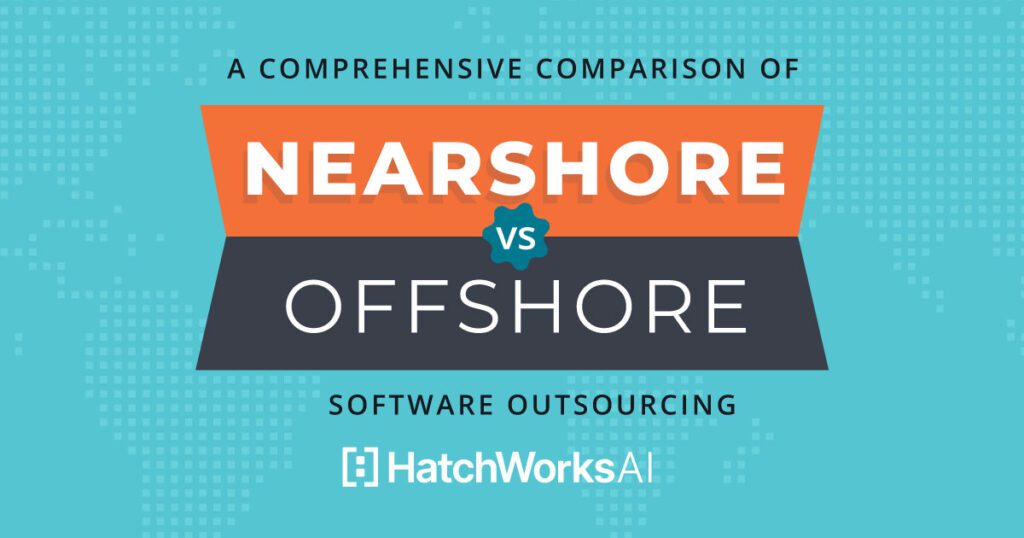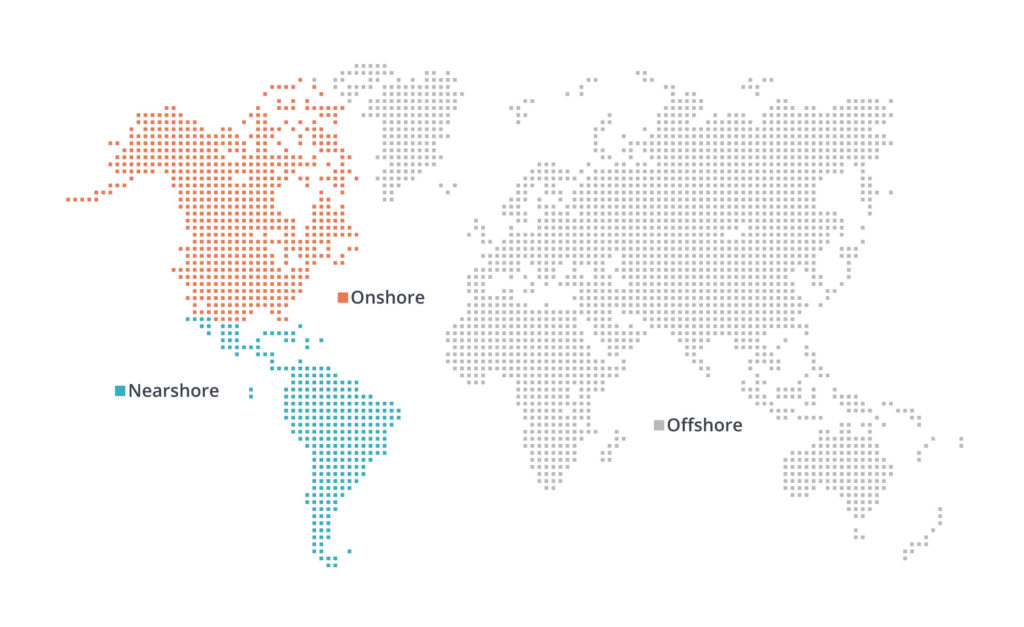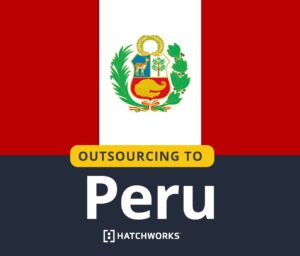Either you’ve been burned by outsourcing software development in the past and want to see if there’s a better way or you’re weighing your options for the very first time.
The Nearshore vs Offshore crossroads is a place many businesses find themselves, especially when it comes to software development needs. We’ve witnessed it with dozens of our own clients and have helped them smoothly transition to a Nearshore model.
But that doesn’t mean offshore doesn’t have its place for certain projects too.

In this article, we’re looking at nearshore vs offshore outsourcing models and helping you choose what will be best for your business.
Here’s what you can expect:
What is Nearshore Outsourcing?
Nearshore outsourcing is when a company delegates specific tasks or projects to an agency, team, or freelancer based in a neighboring country.
For US companies, this means outsourcing to countries in Latin America such as Costa Rica where the cost of services are lower while the quality of work remains high.
This is often used as a way to avoid hiring an in-house team or using the more expensive Onshore outsourcing model where you’d work with someone in the same country as you.
It’s a popular model for software development tasks because Latin America boasts rich software talent and is time zone friendly.
📕Further reading: 24 Nearshore Software Development Statistics to Know in 2024
What is Offshore Outsourcing?
Offshore outsourcing is when a company hires a team in a far-off country to complete work for them. They can work with an offshore company or freelancer who offers services they need but can’t or don’t want to handle internally.
An example of offshore destinations would be a US company working with an outsourcing partner in the Philippines or India. This choice is mainly about saving money, as these distant teams usually cost less.
But they also come with big time zone differences and cultural gaps which can make communication and collaboration more challenging. For some businesses, the cost benefits are worth these extra hurdles.
Outsourcing Software Development: Nearshore vs Offshore Providers
While nearshore and offshore outsourcing models both involve working with a team from another country, there are some key differences that will impact which model is right for your business needs.
Below is a table that outlines these core differences. And below that, we’ll look at the differences that matter most when outsourcing software development services.
| Nearshore outsourcing | Offshore outsourcing | |
|---|---|---|
|
Real-time collaboration
|
Same or similar time zones
|
5-12 hour time zone difference
|
|
Cultural affinity
|
Very similar work culture and practice
|
Not as similar
|
|
English language proficiency
|
Moderate to low proficiency across Latin America
|
Wide range from Very Low to High across Europe and Asia
|
|
Travel accessibility
|
2-5 hour flights, less complicated than traveling to Europe or Asia
|
8+ hour flights, plus an increased need for overnight accommodations
|
|
Project security
|
Increased likelihood of shared or similar data protection laws
|
Not likely to share data protection laws
|
|
Cost savings
|
Not as pricey as Onshore
|
Affordable but hard to manage
|
|
Quality
|
Equal or great quality to Onshore
|
Lower quality than Onshore
|
|
Risks
|
Medium risk
|
High risk
|
Geographic Proximity and Time Zone Alignment
🥇Winner🥇= Nearshore Software Development| Nearshore Software Development | Offshore Software Development |
|---|---|
|
Is in the same or similar timezone to you making quick or real-time collaboration easier.
If needed, you can visit the outsourced team relatively easily.
|
Will have a 5-12 hour time zone difference which can cause delays to project development and trouble communicating effectively.
Any travel between countries would be long and expensive.
|
One major difference between Nearshoring and Offshoring is the geographical proximity of the outsourced team to the company hiring them.
With Nearshore Software Development, the close physical location means you’re often in a similar or same time zone as your outsourced team. This alignment allows for more synchronized work hours and smoother real-time collaboration.
Imagine needing a quick update or having to make a sudden change in your project; with nearshore, your team is just a quick video call or Slack message away. You can unblock projects, adjust to changing requirements, get updates, and collaborate in real time.

On the other hand, offshore outsourcing usually involves significant time zone differences. While this can be managed, it often leads to delayed communications and a need for more rigid scheduling.
Let’s say you’re in the US and your offshore team is in Asia; when you’re wrapping up your day, they’re just starting theirs. This can slow down the pace of work, especially if immediate feedback or decisions are needed.
Time zone differences can impact not just daily communication but also the overall project timeline and efficiency. While some see this as a manageable challenge, others find it adds unnecessary complexity, particularly in fast-paced or Agile project environments.
Cultural Affinity and Communication
🥇Winner🥇= Nearshore Software Development
| Nearshore Software Development | Offshore Software Development |
|---|---|
|
Nearby countries often have overlapping cultures and greater exposure to the other’s language.
This can enhance communication and set the foundation for similar working cultures.
|
Consider the cultural differences between countries in Asia and America.
These differences can unintentionally lead to misunderstandings and misalignment in what’s expected from one another, potentially causing friction and delay.
|
Cultural alignment is another differentiator between the two outsourcing models.
With Nearshoring, the cultural and language divide is narrower. This can make teamwork feel more natural and communication more straightforward.
For instance, if a US company works with a Nearshore team in Latin America, they’re likely to find more in common in terms of work ethics, business practices, and even holidays
However, working with an Offshore software development team somewhere like Asia, may present more cultural barriers, ultimately affecting project deliverables.
For example, a US team might value direct communication and fast decision-making, while their offshore team might have a more hierarchical or formal approach. These subtle yet significant cultural nuances can impact how teams interact, make decisions, and solve problems together.
Nearshore outsourcing usually offers a smoother cultural fit, leading to more effective communication and collaboration. This can have a direct positive impact on the speed and quality of your project’s progress and outcomes.
Cost Differences
🥇Winner🥇= Offshore Development (But Nearshore isn’t far behind!)
| Nearshore Software Development | Offshore Development |
|---|---|
|
Nearshore is lower cost than onshore outsourcing.
While slightly more expensive than Offshore development, Nearshore’s convenience and quality are well worth the additional costs.
|
Generally, Offshore is the lowest cost outsourcing option.
This can be beneficial for businesses but can be more difficult for teams to oversee and manage due to time zone differences and cultural barriers.
|
Companies often choose Nearshore and Offshore outsourcing services because they’re a cheaper alternative to hiring an in house team or onshore outsourcing.
So you save with both models. But if doing a side by side comparison of the costs, Offshore software development has a slight edge.
Offshore rates, whether for an architect, developer, or QA engineer, are generally lower compared to nearshore. This makes offshore outsourcing an attractive option for businesses looking to maximize their budget.
Here is a breakdown of estimate costs for Offshore and Nearshore outsourcing:
| Role | Nearshore | Offshore |
|---|---|---|
|
Architect
|
$72 - $96
|
$47 - $95
|
|
Business Analyst
|
$54 - $68
|
$31 - $81
|
|
Scrum Master
|
$50 - $79
|
$44 - $74
|
|
UX/UI Designer
|
$48 - $75
|
$29 - $71
|
|
DevOps
|
$59 - $82
|
$29 - $79
|
|
Lead Developer
|
$66 - $82
|
$41 - $82
|
|
Associate Developer
|
$41 - $53
|
$21 - $53
|
|
Mid Level Developer
|
$53 - $66
|
$27 - $65
|
|
Senior Developer
|
$65 - $82
|
$34 - $76
|
|
Associate QA Engineer (Manual)
|
$34 - $52
|
$18 - $44
|
|
Mid Level QA Engineer (Manual)
|
$42 - $59
|
$22 - $59
|
|
Senior QA Engineer (Manual)
|
$53 - $66
|
$25 - $61
|
|
Associate QA Engineer (Automated)
|
$35 - $55
|
$22 - $51
|
|
Mid Level QA Engineer (Automated)
|
$48 - $62
|
$25 - $63
|
|
Senior QA Engineer (Automated)
|
$59 - $72
|
$29 - $74
|
But the Offshore vs Nearshore cost difference isn’t as wide as you might think, especially when you factor in the value of easier communication and cultural alignment.
For example, a Nearshore software development team might charge more than an offshore team, but the reduced communication barriers and time zone alignment can lead to more efficient project management.
This efficiency can offset the higher hourly rates by reducing the overall project duration and the potential for costly misunderstandings. Plus you have to look at the value of the software development team you’re getting for the price.
The good news is that no matter which you choose, outsourcing software development offers you lower cost services than you’ll find onshore.
Access to Talent
🥇Winner🥇= Nearshore Outsourcing
| Nearshore Software Development | Offshoring Software Development |
|---|---|
|
Tech talent in Latin America is booming, especially in locations like Costa Rica, Colombia, and Peru.
Their focus on upskilling makes them an attractive option for less than it costs onshore.
|
Offshore software development talent can vary drastically but there are pools of talent worth your while if you can find them.
|
Both Nearshore and Offshore services open doors to a global talent pool.
When you go Nearshore, you’re able to tap into the growing software development markets of Latin America. Take Costa Rica as an example—their tech sector is expected to increase by 180.2 million U.S. dollars (+55.05 percent) between 2023 and 2028. As a result, there will be a surge of tech talent in that country and in the wider region.
Offshore options such as India also offer diverse tech talent businesses can tap into.
However, the greater geographic and cultural distance can sometimes pose challenges in aligning this talent with the specific needs and context of a Western-based company.
Largely, your outsourcing success and access to talent come down to the outsourcing partner you choose. The best Nearshore models will have US bases that work with Latin American teams.
At HatchWorks we have our American offices oversee the sourcing and management of Latin American software developers so that we can ensure only the best of the region work on projects and that they’re kept up to date on skills and emerging software trends including the use of generative AI.
Pros and Cons of Nearshore and Offshore Outsourcing
What’s to gain and what’s at risk when using either nearshore or offshore software development services?
Below we’ve onshore and offshore benefits to look out for as well as potential drawbacks you may face.
Advantages of Nearshore Outsourcing
There are many reasons why you should consider Nearshore Software Development, but these three are at the core:
- Nearshore provides aligned time zones for real time collaboration.
Today, multidisciplinary Agile teams are the norm in software development. The fact that Agile teams are so productive is due, in part, to their foundation in collaboration, iteration, and short feedback loops. Having the day’s work cycle shared is the main requirement for Agile to function in a remote environment. Nearshore development enables that real-time collaboration by being aligned by time zone, not cubicles. - Nearshore expands your talent pool.
Location doesn’t matter, talent does. A large number of technology workers are now available in Latin America, thanks to the region’s extensive technology education program. They are adept at leveraging modern technology and Agile methodologies to integrate seamlessly into a distributed team. The strong cultural affinity between Latin America and the US, along with the region’s English proficiency, makes collaboration even easier. - Nearshore provides you more value for your investment.
There is a severe shortage of talent in the US, and salary demands are at an all-time high. A Nearshore Software Development approach yields better value and a bigger pool of resources. On top of that, the quality of talent results in little to no dropoff in productivity compared to Onshore. Nearshore can be leveraged without investing in a new region, allowing companies to fully leverage the growing software development culture in Latin America.
Need help choosing a Nearshore partner? Check out our article on the Top 9 Nearshore Software Development Companies.
Disadvantages of Nearshore Software Development Teams
Here are the most common disadvantages of using Nearshore partners:
- Nearshore can be more expensive than an Offshore provider.
Some Offshore companies are able to provide significant cost savings compared to Nearshore. Don’t forget to factor in the cost of communicating and collaborating with teams in a significantly different time zone when Offshoring. - Nearshore developers speak English as a second language.
There are always some language and cultural differences when outsourcing to another country. That said, English language proficiency is growing in Latin America and the cultural differences are less pronounced compared to some Offshore countries. - Nearshore markets are still maturing.
There’s no denying it; there are more Offshore options available. Finding the right Nearshore partner for niche projects may be difficult. But this could be changing. Deel’s 2022 State of Global Hiring Report shows that growth in Latin America is outpacing even APAC. Organizations are looking for more than just software development by moving more product and UI/UX capabilities abroad too.
Want to use Nearshore Software Development and minimize any risks? Check out our proven strategies for mitigating Nearshore Software Development risks.
Projects Best Suited for Nearshore Outsourcing Companies:
- Digital B2B, B2C, and SaaS Solutions
- Those requiring real-time collaboration, but not necessarily face-to-face
- Those leveraging an Agile approach
- Strategic and more ambiguous projects that require real-time discovery and collaboration
- Development of new software solutions
- Modernization of complex legacy software solutions
Advantages of Offshore Software Development Teams
Offshore outsourcing has been popular in the past for a reason. Here are those reasons:
- You can save money.
One of the main reasons why organizations choose to outsource is the huge amount of cost savings they get. As you might know, the main reason behind this is the difference in wages between developed and developing countries. - You get access to talent you might not find in-house.
You get access to a wide variety of skill sets that you might not be able to find locally. If you choose to outsource to a country that has a robust software development culture, you’re likely to find a lot of professionals with the skill set that you need. - You can Offshore business processes requiring repetitive tasks.
When you hire skilled developers from another part of the world, collaboration can be difficult. This factor makes Offshore ideal for projects or tasks that DON’T require high levels of collaboration or an Agile development process.
Disadvantages of Offshore Software Development Teams
Here are the most common disadvantages of using Offshore Software Development:
- Cultural differences are more pronounced with Offshore.
Communication may be harder due to cultural misalignment as well as time zone issues. - You have limited control and oversight when Offshoring.
You’ll have less control of the project when working with partners in a distant country. This can be a problem if you need to give detailed feedback. You may need to adjust your work or sleep schedule to stay in communication with your Offshore team. - It is harder to travel to Offshore locations.
Europe and Asia are not as accessible as Latin America when it comes to quick flights. If you need to travel to your partner’s office, be prepared for an overnight journey. This is not necessarily the case with Nearshore. A flight from Atlanta to San San José, Costa Rica is quicker than one to San Jose, California.
Want to separate fact from fiction when it comes to outsourcing? Read our article: 8 Outsourcing Myths Debunked: Our Deep Dive into Common Misconceptions
Projects best suited for successful Offshore outsourcing:
- Non-automated processes requiring repetitive tasks
- IT support projects
- Less strategic ambiguous projects
- Projects that don’t require high collaboration and Agile process
- Projects not as impacted by high turnover
Choosing Between Nearshore and Offshore: Factors to Consider
If you’re not yet sure which outsourcing model to choose, consider these three factors:
Your Project Requirements
Every project has its unique demands, whether it’s specialized skills, technology stacks, or development methodologies.
It’s crucial to analyze the specifics of your project to determine which outsourcing model offers the expertise and resources best suited to your project’s needs.
Your Budget Constraints
Budget is often a determining factor in outsourcing decisions. While offshore can offer cost savings, nearshore may provide better value in the long run.
Assessing your financial flexibility and how it aligns with the pricing structures of each model will guide you toward a financially viable choice.
Your Cultural Compatibility
Effective communication and cultural alignment can significantly impact the success of a project. If real-time collaboration and minimal cultural barriers are priorities for your project, nearshore might be the more suitable option.
But if these aspects are less critical compared to substantial cost savings, offshore vendors could be more advantageous.
Reduce Project Development Costs without Compromising on Quality with Nearshore Software Development
HatchWorks AI is a US-based Nearshore software development company that combines local, high-touch service with the affordability and scale of Nearshore outsourcing.
To leverage the talent of Latin America while reducing costs, contact us today.




